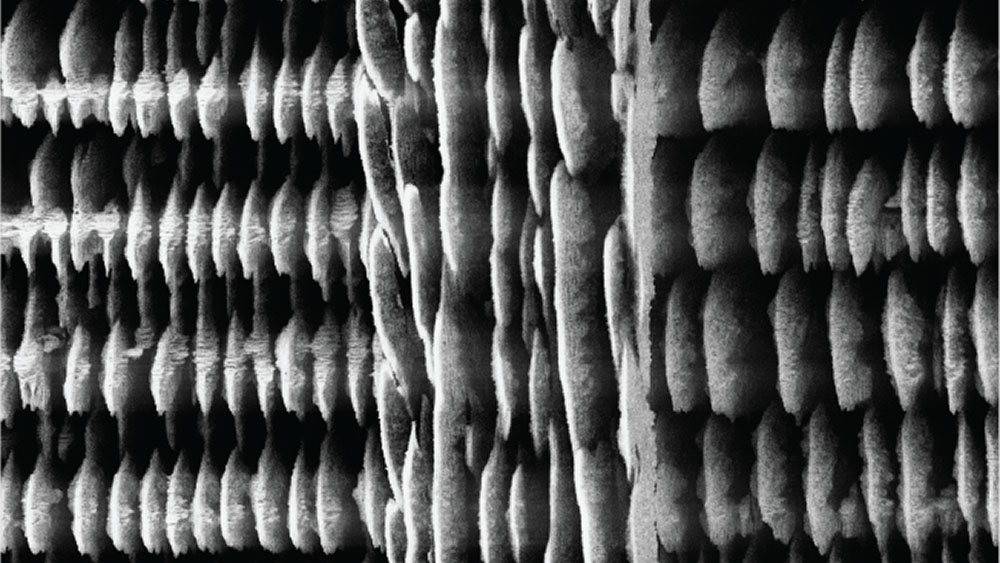Oct 14, 2024
(Nanowerk News) Researchers at KTH Royal Institute of Technology demonstrated a 3D printing method for fabricating glass micro-supercapacitors (MSCs) that reduces the complexity and time required to form the intricate nanoscale features MSCs need.
The advance could potentially lead to more compact and energy-efficient portable devices, including self-sustaining sensors, wearable devices and other Internet of Things applications, says Frank Niklaus, professor of micro- and nanosystems at KTH. Their study was published in ACS Nano (“3D Printing of Hierarchical Structures Made of Inorganic Silicon-Rich Glass Featuring Self-Forming Nanogratings”).
The new method addresses two key challenges to fabricating such devices. A micro-supercapacitor’s performance is largely determined by its electrodes, which store and conduct electrical energy. So they need more electrode surface area, and they need nanoscale channels to facilitate rapid ion transport. Po-Han Huang, who was lead author of the study at KTH, says the new research addresses both challenges with through ultrashort laser pulse 3D printing technology.
 A close up of 3D-printed Si-rich glass micro-supercapacitors (MSCs) on silicon substrates. Magnified by 4720 times. (Image: KTH Royal Institute of Technology)
The researchers discovered that ultrashort laser pulses can induce two simultaneous reactions in hydrogen silsesquioxane (HSQ), a glass-like precursor material. One reaction results in the formation of self-organized nanoplates, while the second converts the precursor into silicon-rich glass, which is the foundation of the 3D printing process. This enables the fast and precise fabrication of electrodes with plenty of open channels, which maximizes surface area and speeds up ion transport.
The researchers demonstrated the approach by 3D-printing micro-supercapacitors that performed well even when charged and discharged very quickly.
“Our findings represent a significant leap forward in microfabrication, with broad implications for the development of high-performance energy storage devices,” Huang says. “Beyond MSCs, our approach has exciting potential applications in fields such as optical communication, nanoelectromechanical sensors and 5D optical data storage.”
The implications are also significant for technologies presently in common use. Supercapacitors of the non-micro type are already collecting energy generated during braking, stabilizing power supply in consumer electronics, and optimizing energy capture in renewable energy, Niklaus says. “Micro-supercapacitors have the potential to make these applications more compact and efficient.”
A close up of 3D-printed Si-rich glass micro-supercapacitors (MSCs) on silicon substrates. Magnified by 4720 times. (Image: KTH Royal Institute of Technology)
The researchers discovered that ultrashort laser pulses can induce two simultaneous reactions in hydrogen silsesquioxane (HSQ), a glass-like precursor material. One reaction results in the formation of self-organized nanoplates, while the second converts the precursor into silicon-rich glass, which is the foundation of the 3D printing process. This enables the fast and precise fabrication of electrodes with plenty of open channels, which maximizes surface area and speeds up ion transport.
The researchers demonstrated the approach by 3D-printing micro-supercapacitors that performed well even when charged and discharged very quickly.
“Our findings represent a significant leap forward in microfabrication, with broad implications for the development of high-performance energy storage devices,” Huang says. “Beyond MSCs, our approach has exciting potential applications in fields such as optical communication, nanoelectromechanical sensors and 5D optical data storage.”
The implications are also significant for technologies presently in common use. Supercapacitors of the non-micro type are already collecting energy generated during braking, stabilizing power supply in consumer electronics, and optimizing energy capture in renewable energy, Niklaus says. “Micro-supercapacitors have the potential to make these applications more compact and efficient.”
 A close up of 3D-printed Si-rich glass micro-supercapacitors (MSCs) on silicon substrates. Magnified by 4720 times. (Image: KTH Royal Institute of Technology)
The researchers discovered that ultrashort laser pulses can induce two simultaneous reactions in hydrogen silsesquioxane (HSQ), a glass-like precursor material. One reaction results in the formation of self-organized nanoplates, while the second converts the precursor into silicon-rich glass, which is the foundation of the 3D printing process. This enables the fast and precise fabrication of electrodes with plenty of open channels, which maximizes surface area and speeds up ion transport.
The researchers demonstrated the approach by 3D-printing micro-supercapacitors that performed well even when charged and discharged very quickly.
“Our findings represent a significant leap forward in microfabrication, with broad implications for the development of high-performance energy storage devices,” Huang says. “Beyond MSCs, our approach has exciting potential applications in fields such as optical communication, nanoelectromechanical sensors and 5D optical data storage.”
The implications are also significant for technologies presently in common use. Supercapacitors of the non-micro type are already collecting energy generated during braking, stabilizing power supply in consumer electronics, and optimizing energy capture in renewable energy, Niklaus says. “Micro-supercapacitors have the potential to make these applications more compact and efficient.”
A close up of 3D-printed Si-rich glass micro-supercapacitors (MSCs) on silicon substrates. Magnified by 4720 times. (Image: KTH Royal Institute of Technology)
The researchers discovered that ultrashort laser pulses can induce two simultaneous reactions in hydrogen silsesquioxane (HSQ), a glass-like precursor material. One reaction results in the formation of self-organized nanoplates, while the second converts the precursor into silicon-rich glass, which is the foundation of the 3D printing process. This enables the fast and precise fabrication of electrodes with plenty of open channels, which maximizes surface area and speeds up ion transport.
The researchers demonstrated the approach by 3D-printing micro-supercapacitors that performed well even when charged and discharged very quickly.
“Our findings represent a significant leap forward in microfabrication, with broad implications for the development of high-performance energy storage devices,” Huang says. “Beyond MSCs, our approach has exciting potential applications in fields such as optical communication, nanoelectromechanical sensors and 5D optical data storage.”
The implications are also significant for technologies presently in common use. Supercapacitors of the non-micro type are already collecting energy generated during braking, stabilizing power supply in consumer electronics, and optimizing energy capture in renewable energy, Niklaus says. “Micro-supercapacitors have the potential to make these applications more compact and efficient.”

